How to give yourself an entirely new set of neck and upper back problems that aren’t related to your horrible quarantine desk goblin posture: helmet setups!
One of the bigger personal projects I’ve taken up over the blur of flat time circle disorientation that has been the past 7 months has been getting my personal helmet and night vision setup ready to go.
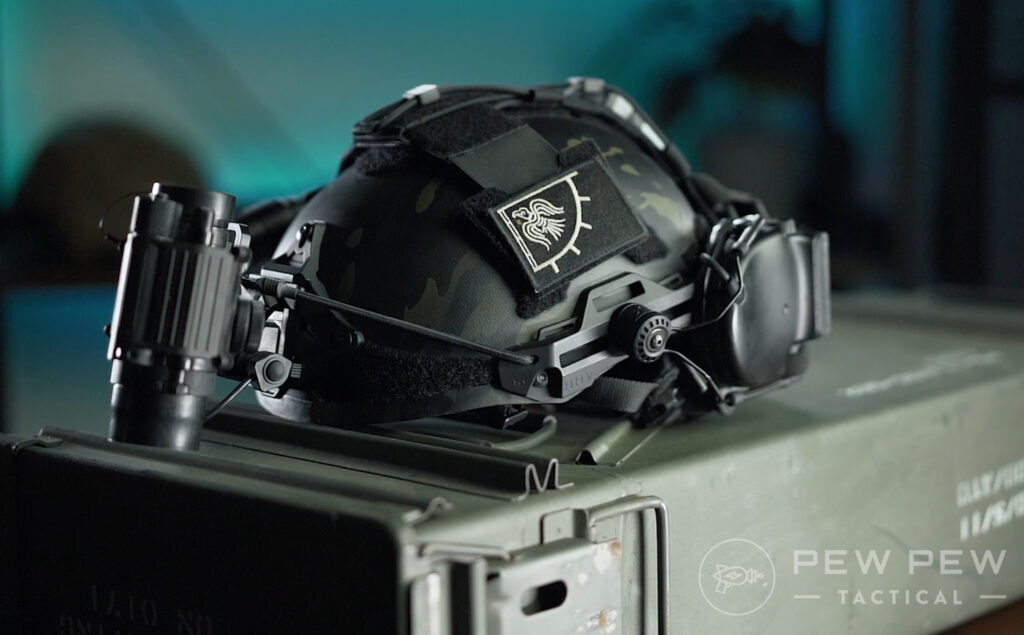
And while there are still a few things I’ll likely wind up tweaking in the future, I’m digging the layout thus far and figured I’d give you guys a quick look at some of the bits and thought process involved in putting together.
Standard disclaimers apply, I’m just a nerd doing fun nerd stuff and sharing what I’ve picked up along the way.
So listen to me if you want, or go find one of several thousand sheepdog operator channels that have covered similar topics — it doesn’t make a huge difference to me ¯\_(ツ)_/¯
Boom, here’s the video of everything in action:
Table of Contents
Loading…
The Helmet
First up! The basis for the entire build is a Hard Head Veteran ATE gen 2 — which is probably one of the most screeched about pieces of PPE I can find online outside of the never-ending steel-armor self frag discussion.
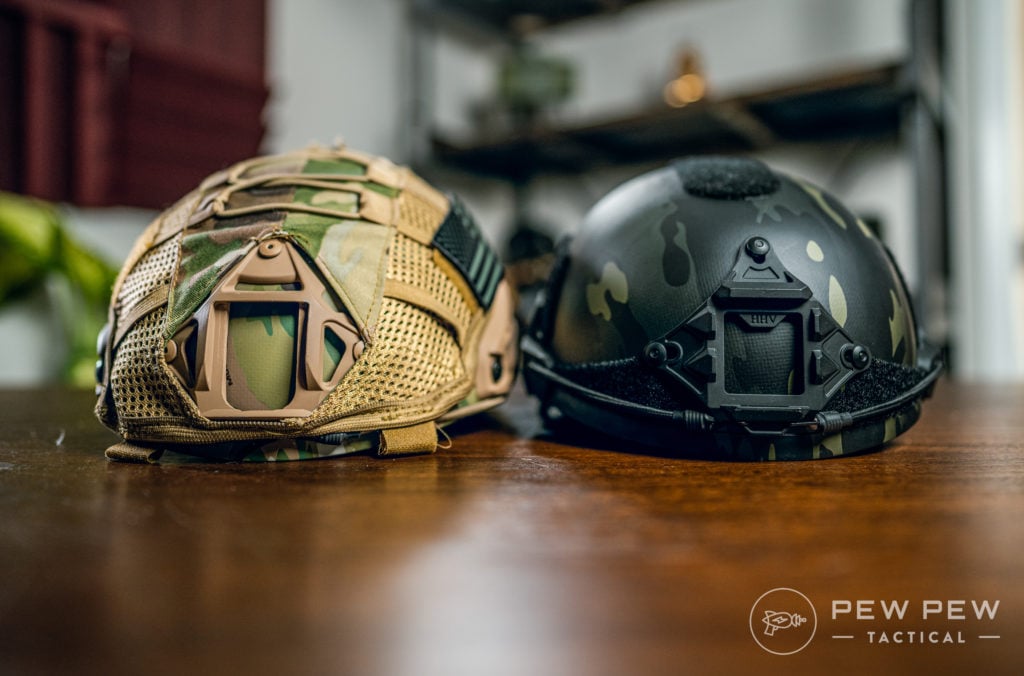
The ATE boasts NIJ IIIA protection — achieved by exporting American-made aramid materials overseas for assembly — and therein lies the controversy.
Wander too far into any internet gear circle and I’m sure you’ll find folks willing to argue all sorts of specifics about why the HHV lid’s NIJ rating is unreliable because of arbitrary hand wringing over foreign production process reliability.
Inevitably this always winds up being based in some way on an ancient testing video In-Range TV did about backface deformation versus a standard Ops-Core helmet.
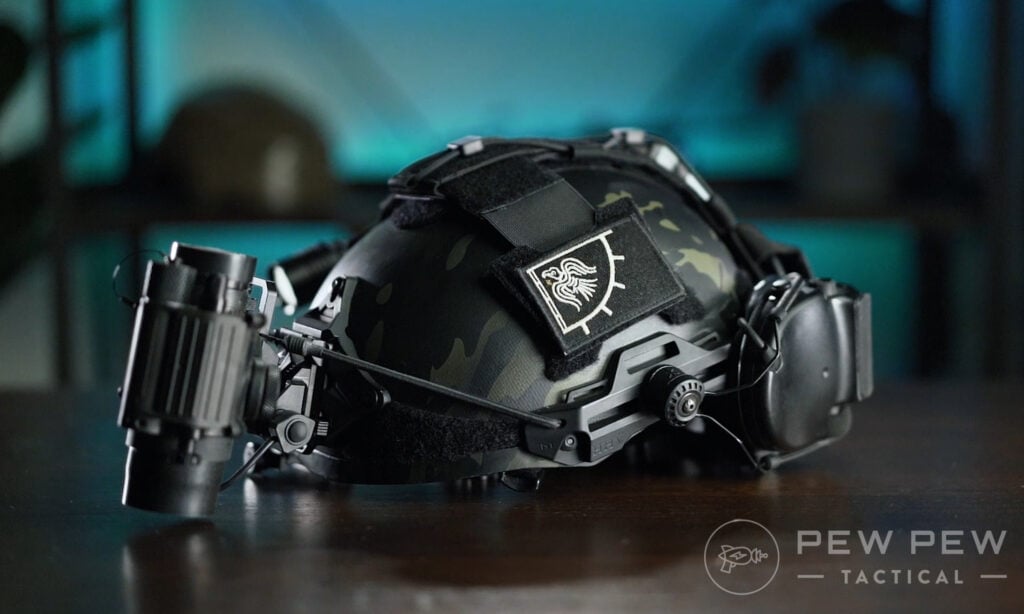
We’re not going to get into that can of worms, but feel free to do the research yourself if you’d like. But HHV does list all their testing results publicly and will soon producing from their Texas facility.
Realistically my job doesn’t entail me getting shot at, and if I’m in a position where I have to worry about the ballistic integrity of my highspeed trilby, several things have probably gone very, very wrong.
And to that point — if you also don’t get shot at for a living, you could just as well save some weight and money and grab a non-ballistic bump helmet or even a skull crusher mount.
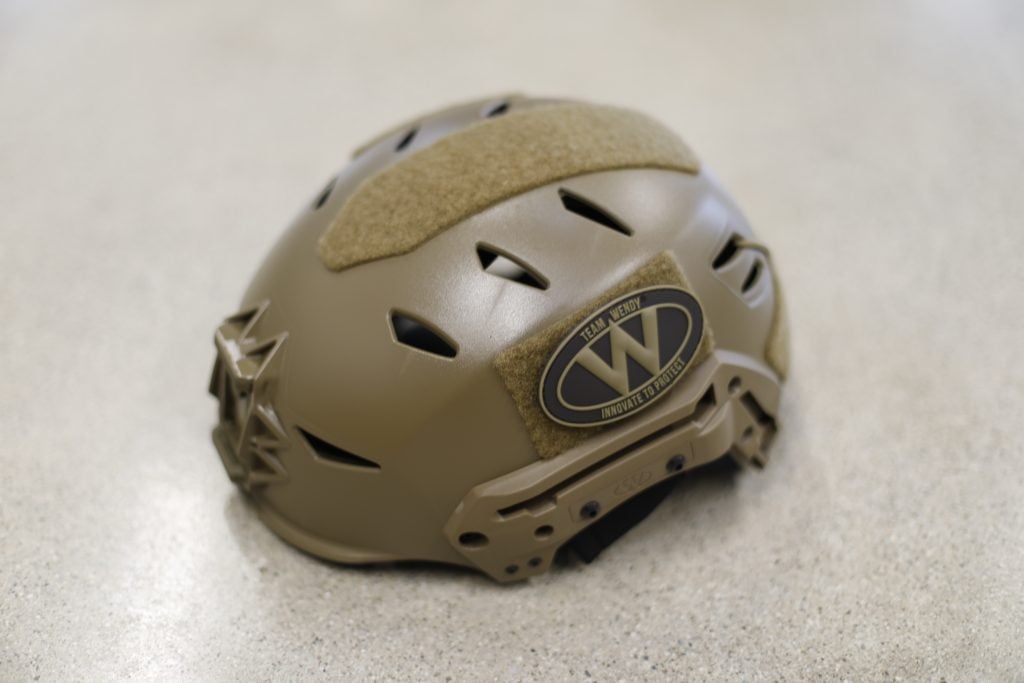
I just happened to have the ATE lying around the PPT office and figured it’d be a good chance to get a feel for it.
The helmet’s about 3lbs or so without any of the tactadork gear I have mounted on it — so it’s not awful, but prolonged wear with the full suite of night-things and it can get a bit hefty.
While the ATE has a similar cut and profile to a MICH2001 or Ops-Core FAST, they’re actually not quite the same.
Different accessories like helmet covers and such may not fit as a result of the slightly different dimensions.
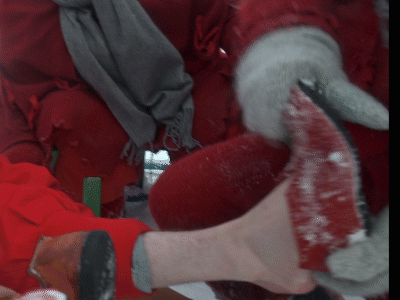
The side rails are also unique — they’re MLOK-based much the same as the team wendy helmet rails, but the size and angles of the HHV’s MLOK mean that some team wendy-specific accessories may not work correctly.
I learned this the hard way with an initial purchase of a Team Wendy ear pro adapter kit which was just straight up incompatible with the HHV’s ARC rails.
So it goes.
Mounting The Nightvision
Upfront is a pretty standard 3-point night vision plate that’ll work with pretty much any standard or USGI-based NVG mount. More on that in a bit.
One of the first changes I personally made to the helmet was throwing in an Ops-Core style harness and Occ-Dial assembly, as I found the stock HHV liner pretty lacking.
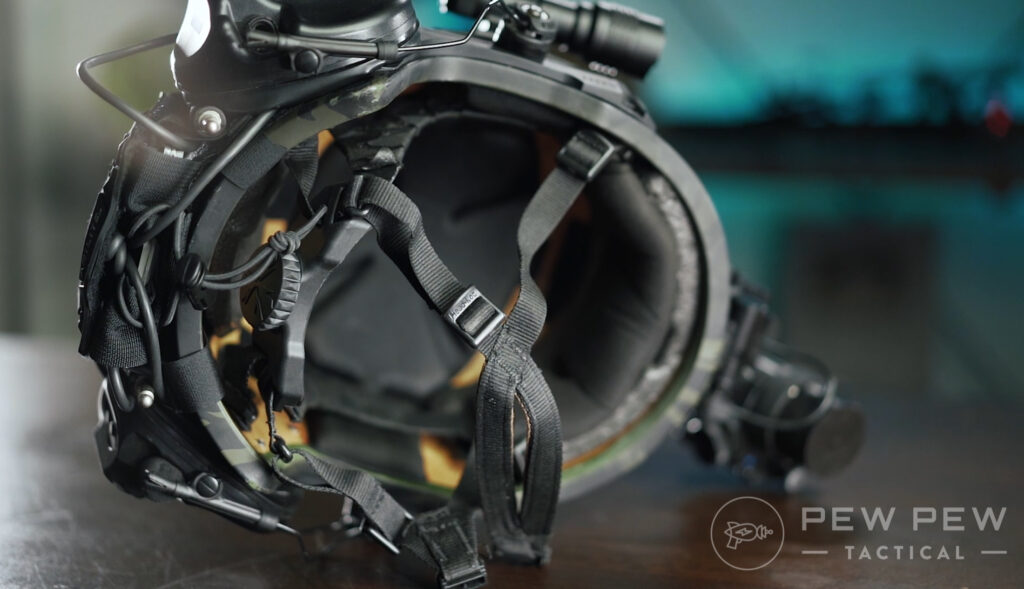
The closure system was a bit more finicky to operate than standard Fastex buckles found on the occ dial suspension as I have to run my chin strap underneath my jaw because of the hobo beard.
The stock pads themselves are okay — it’s a decent quality foam material that I have no real complaints about, but I’m likely going to swap these guys out for some super Gucci 4D pads at some point in the future.
Outside of that, I made the mistake of leaving the lid in my truck on a hot day in the desert and came back to find that the adhesive on the side velcro had melted.

While melting, they had been pulled up due to the tension from my bridge system.
Not a huge deal and I’ll probably replace the stock velcro with something a bit more robust shortly.
Back up to the night vision setup itself — I’ve got a Night Vision Inc photonis hybrid white PVS-14 on a powered Wilcox dovetail J-arm, attached to the helmet via a Wilcox L4 G24 mount.
Prices accurate at time of writing
Prices accurate at time of writing
-
25% off all OAKLEY products - OAKLEY25
Copied! Visit Merchant
If that sounds like a load of indecipherable jargon, just you wait, because we’ll be doing an in-depth intro to night vision terminology and setups sometime in the near future, but to keep it simple:
I have a piece of spaceman technology mounted to my face that converts ambient night-time photons into electrons and amplifies them into an image sequence that your brain recognizes — giving me the ability to see, shoot, or ride bikes like a jerk in near-complete darkness.
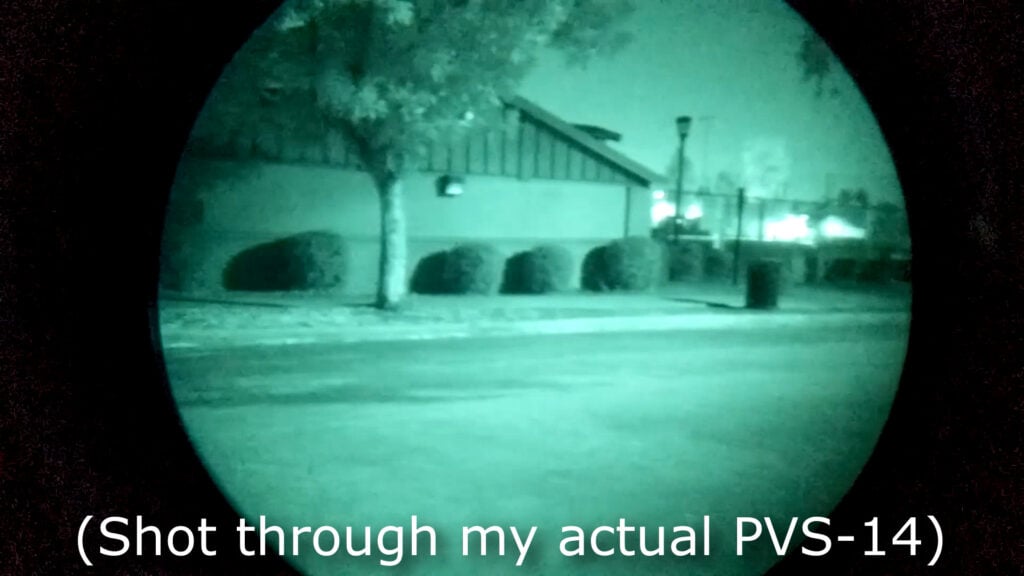
Okay, But… Why?
And since it invariably comes up a lot in civilian circles, let’s just head the ‘why do you need night vision’ question off at the pass.
Because it’s rad as hell bro, that’s why — it’s not like we live in a world driven in any shape by reason anyway.
Once I got over the initial apprehension of dropping a considerable chunk of change on a piece of equipment I figured I wouldn’t really be using super often and I regret nothing- as I’ve found tons of cool uses for them outside of doing shooty stuff.
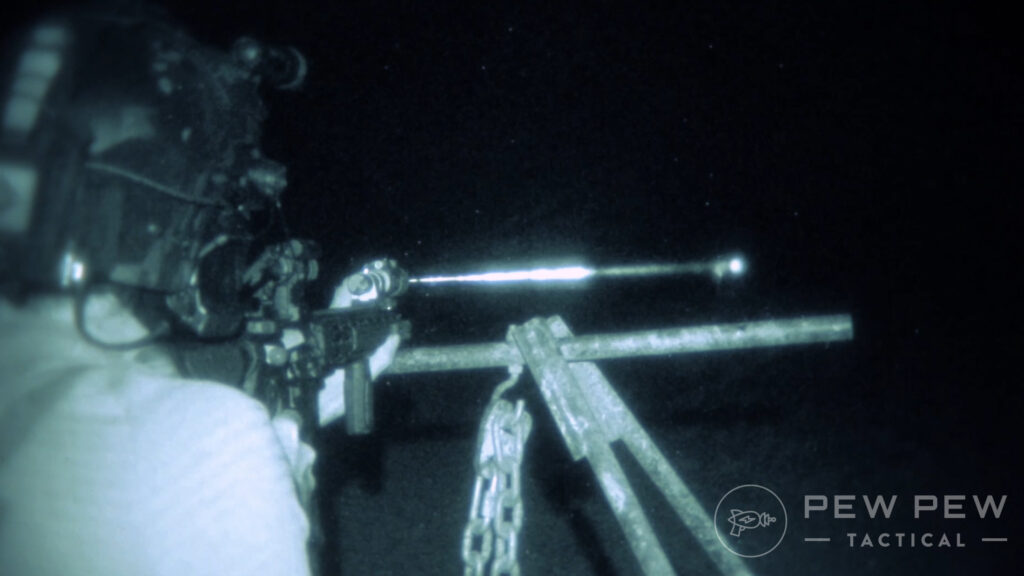
Things like night photography, navigating in the dark while backpacking, etc.
Seriously though, If you’ve never had the opportunity to play with NODS — they’re absolutely incredible, and the unit night vision inc assembled for me is one of the clearest tubes I’ve ever had the pleasure to look through.
Roses Are Red, Nightvision Is Gree- Um… White?
Compared to what you probably think of when the term ‘night vision’ comes to mind, my PVS-14 is built on a white phosphorous tube.
We’ll dig into the details a bit later on, superficially means that the image presented to my eye is a much paler, grey-green hue as opposed to the stereotypical lime-green stuff presented in pop culture.
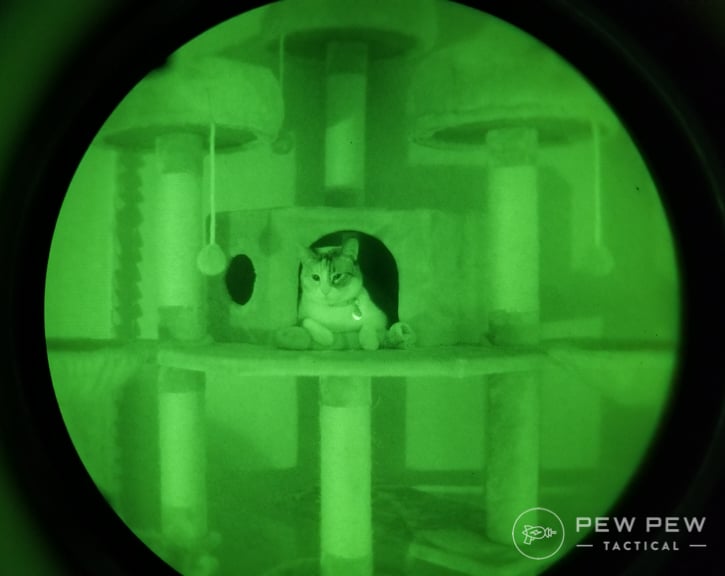
Having used both styles of monocles before, I personally find that white phosphorous produces less strain on my eyes with prolonged use.
It is also not as disorienting to my depth perception as standard green PVS-14s. Whether that’s a placebo effect or not, I’m not sure, but the difference is absolutely noticeable for me.
The unit runs on a single AA battery, and the run time itself is pretty impressive. I’ve had it going for the past few months on the initial battery it shipped with, and it’s still chugging along.
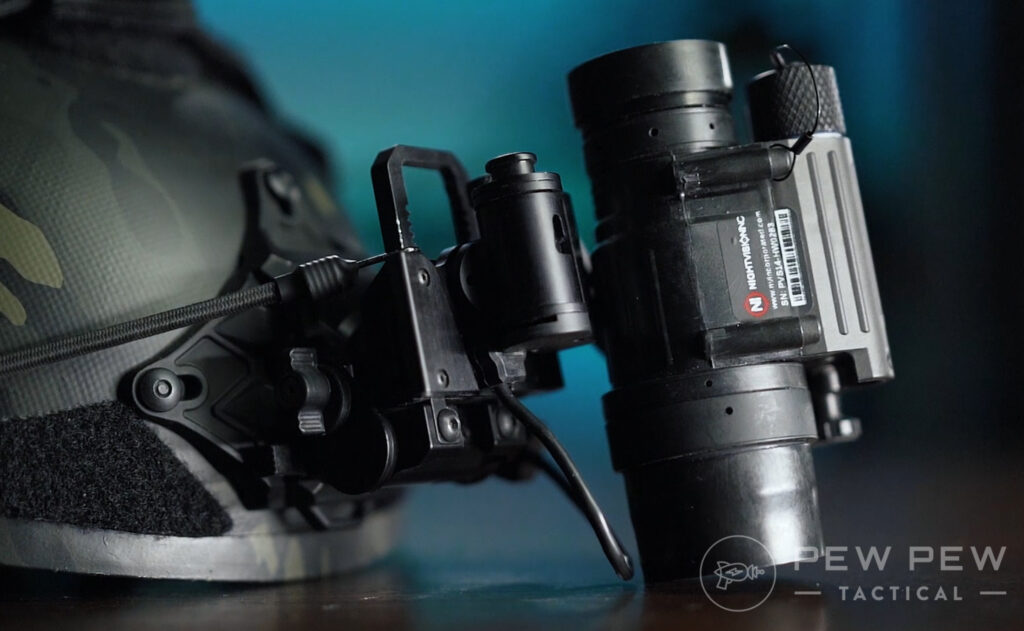
We’ll be doing a breakdown on the difference between monocles and dual tube night vision setups eventually.
But rest assured if you’re on the fence about going with a single tube setup if you’ve got the opportunity, they’re still totally functional for night shooting once you’ve got some time and familiarization logged in.
In my experience running the monocle on my non-dominant eye while keeping my dominant eye open eventually results in my brain combining the two images — assuming I have both the front and rear focal rings set correctly.
It’s a bit hard to explain and you’re still probably going to have some issues with depth perception when interacting with objects close up when you’ve got your focal length set further out.
But fumbling around with a reload or trying to find your dump pouch in the pitch dark is a great way to figure out what part of your skillset is actually committed to muscle memory or not.
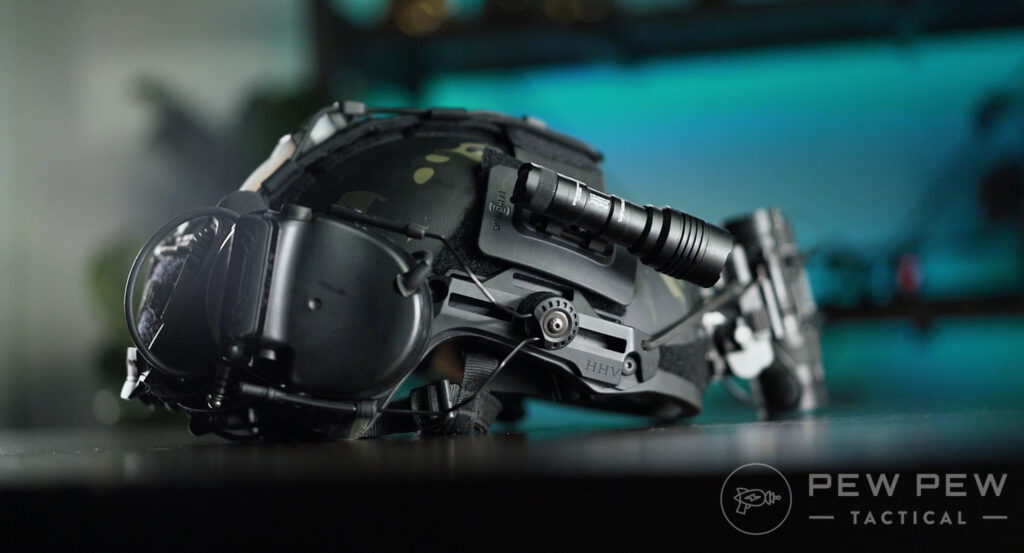
The unit automates and gains depending on ambient light conditions — meaning that the image will either intensify or dim as the situation dictates, so you don’t have to worry about manual adjustments while moving through more dynamic lighting situations.
As I said, there’s an infinite pile of terminology and specifics to demystify when it comes to night vision — especially when it comes to putting things in terms the layman can swallow, but I am super impressed and having a blast with this particular unit that NVI built for me.
More Stuff Means More Tactical
Back to hardware — the Wilcox powered arm serves two purposes. Firstly, it’s got a small push button that inserts into the mount’s rotation button, and electrical contacts on the opposite side that interface with the PVS-14 itself.
This means that pressing the button to rotate the unit up and away from your face automatically turns it off, saving your battery and tube from weird exposures while pointing straight up into the sky.
It’s definitely not necessary, but it’s a cool quality of life feature for sure.
Secondly, the Wilcox dovetail arm is just about the easiest way to achieve the lowest profile possible with a PVS-14 monocle — second maybe to the infinitely rotating Norotos INVG mount that allows you to tuck the unit against the helmet to get even smaller.
Prices accurate at time of writing
Prices accurate at time of writing
-
25% off all OAKLEY products - OAKLEY25
Copied! Visit Merchant
Still, compared to the super shitty USGI issued Rhino mounts — the Wilcox arm keeps the unit much lower vertically, meaning you’re much less likely to bonk into shit when moving through doorways, etc.
It’s also adjustable and can be set to sit in front of either eye, with fine-tuning available via a set screw that sets the limits of rotation.
The arm mounts directly to the G24 via that dovetail slot, and the G24 attaches via a lateral locking lever.
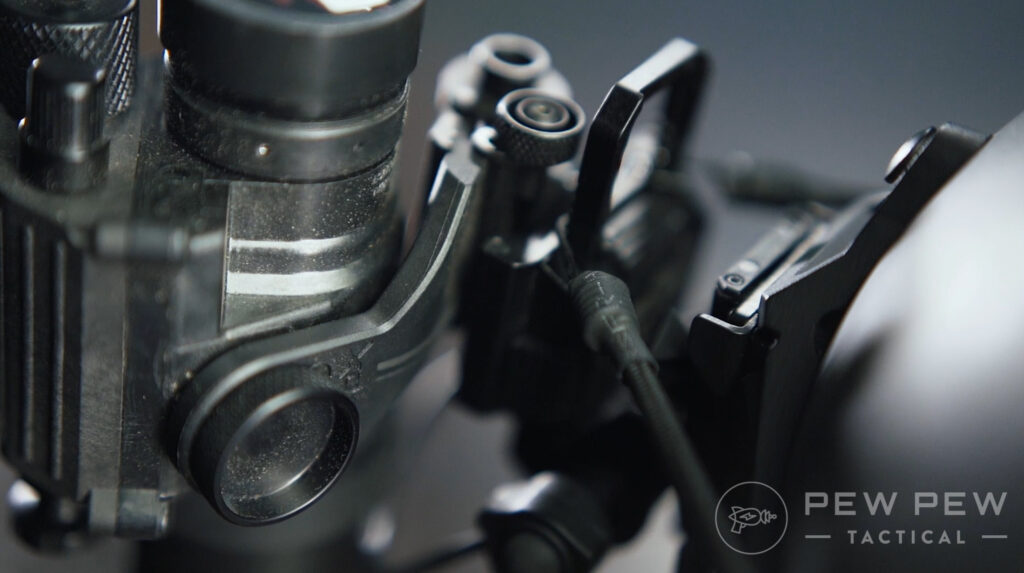
Since the G24 has just a tiny bit of play when sitting in the HHV mount, I’m using the helmet’s bungee hooks to provide a tiny bit of tension against the arm which more or less eliminates wiggles when flipped down.
Obviously, hanging a big chunk of technology in front of your nose means the helmet’s center of gravity is now going to be tilted forward, so I’ve added an Agilite bridge system to the lid that allows me to run counterweights in this pouch on the rear.
You can get fancy and highspeed here if you want to probably, but I snagged some adhesive fishing weights on Amazon for super cheap and they honestly work perfectly — preventing the unit from pulling your entire setup down and forward.
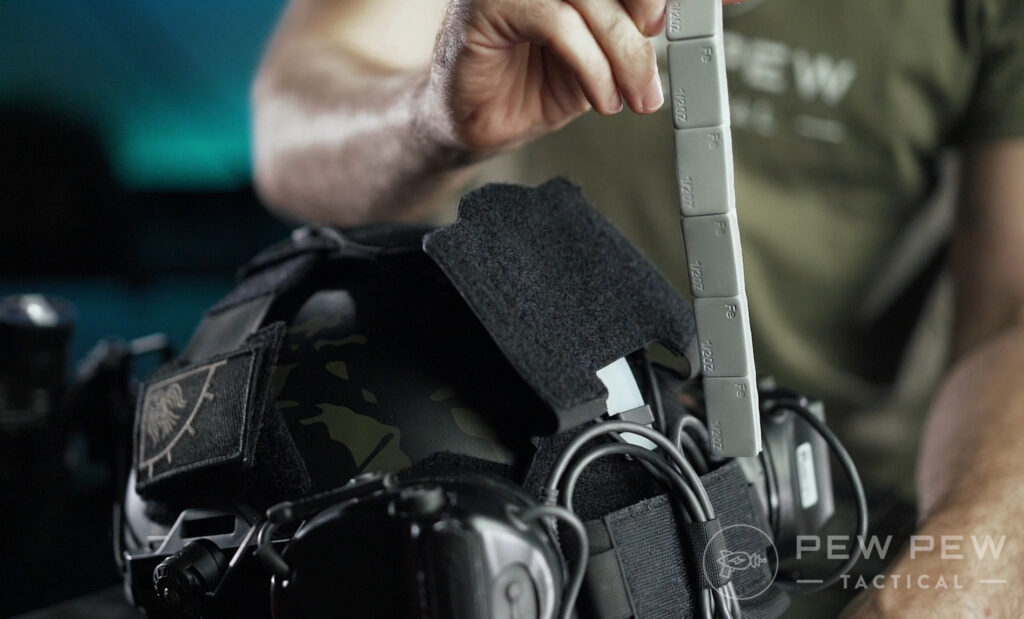
Since I’ve had the unit for a longer amount of time than I’ve had a weapon-mounted laser, I originally was using this setup for zero dark thirty-night bike missions and added a red V-Lite strobe to the back of the helmet.
Hopefully, making being struck and killed by a car slightly less likely.
Though having a visual indicator of your position on your helmet when doing spooky nighttime gun stuff is pretty useful also.
Off to the right side, I’ve got a Streamlight Pro Tac rail mount 1, mounted to an Echo Arms M-LOK light mount via a Unity Tactical M-LOK adapter.
This is essentially just an easy way to have white light for administrative duties at night without donning and doffing the whole setup every time.
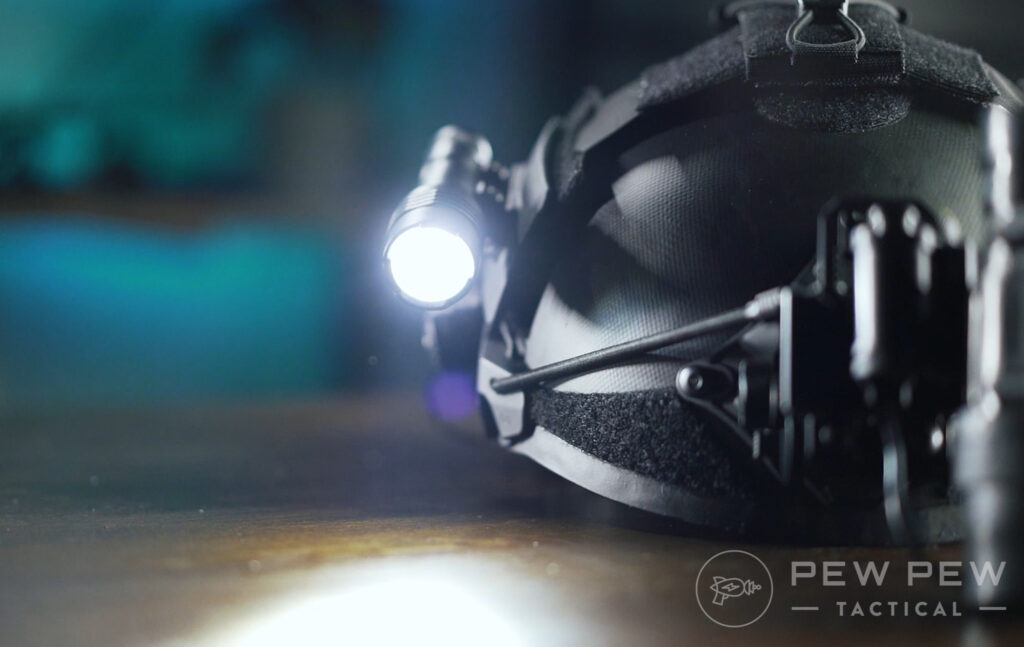
Any M-LOK compatible scout light will work with the setup, but considering it’s a Streamlight, it means that I also have helmet-mounted party mode to boot.
Lastly, integrated ear protection when running a huge chunky ass setup like this is pretty much a must, as trying to wear a normal electronic ear pro band underneath the helmet is gonna crush that grape something fierce.
I snagged a pair of Peltor Comtac 2s from a friend that was already mounted to the Unity Tactical MARK system, albeit for OPS core style ARC rails.
Prices accurate at time of writing
Prices accurate at time of writing
-
25% off all OAKLEY products - OAKLEY25
Copied! Visit Merchant
Unity was however cool enough to send me the adapter plates for MLOK helmet rails, and to my surprise, they work great on the non-standard HHV M-LOK rails! Big tight award shouts out to Unity for that.
The MARK allows the Comtacs to swivel back and out of the way when not in use, and personally, I find that they get the earpro sitting pretty close to an optimal position when swiveled in.
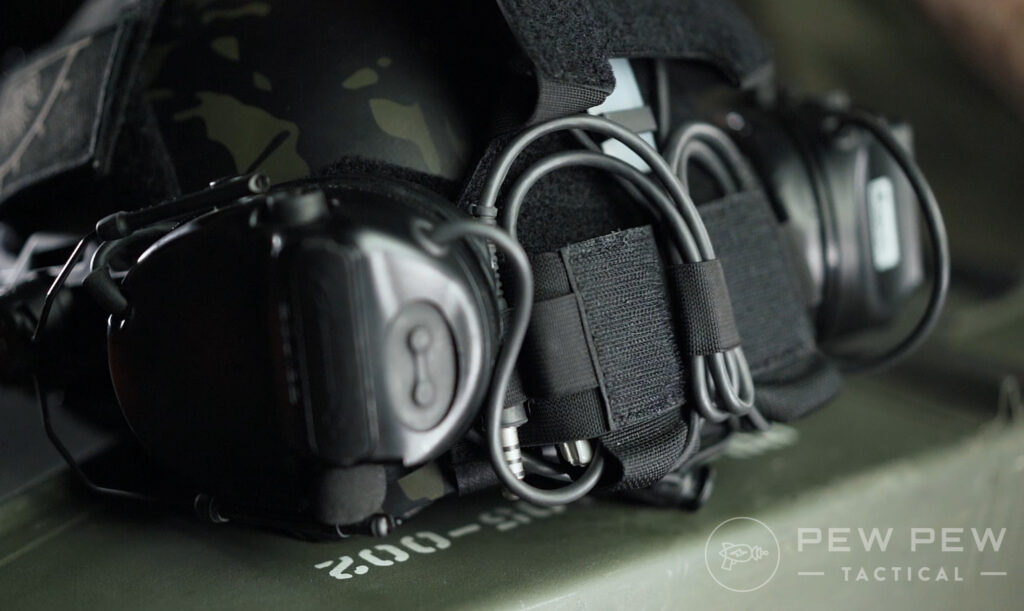
Previously, the proprietary mount for HHV’s M-LOK rails left me feeling like my earpro were either way too tight or flopping off my ears — but the MARK has rectified that situation nicely.
As this is a dual comms pair of Comtacs, I’ve routed all the excess cable back into the Agilite’s webbing so that I don’t have a medusa of wiring flying around the lid.
Parting Shots
So there you have it — that’s been the setup I’ve been utilizing while getting into the night vision game and as I mentioned — I’ve been digging it thus far.
Hopefully, this gives you a bit of an idea of what kind of ancillary accessories you might need to run to really get the most out of your night vision setups.
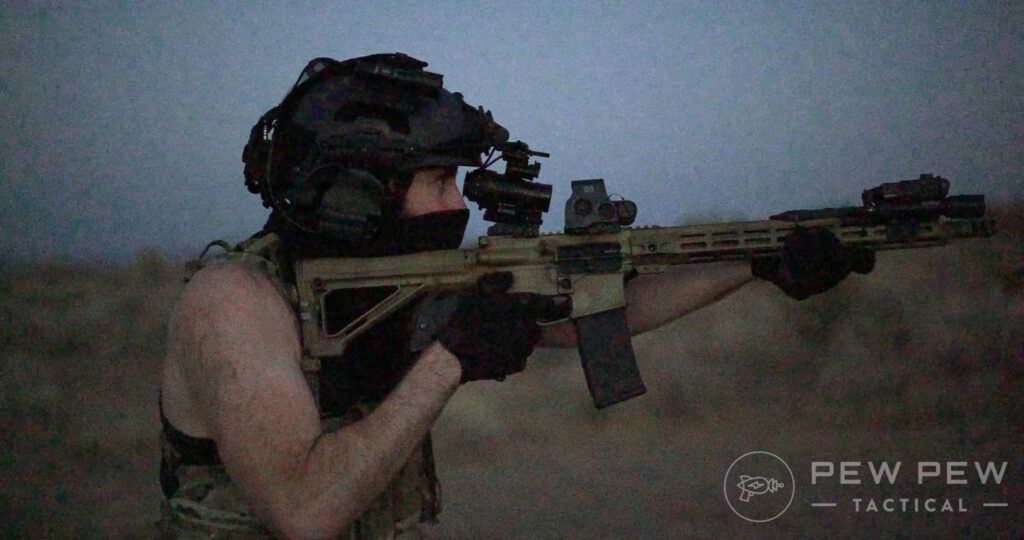
If you’re like me you probably didn’t realize how much other pieces of kit you might need to buy and bolt on once you’ve passed the point of no return in buying a night vision unit itself.
how do you run your setups? What would you improve on mine? Let me know in the comments! We’ll be doing a huge update to this article soon, but take a look at our Best Night Vision Goggles for more night vision ideas!

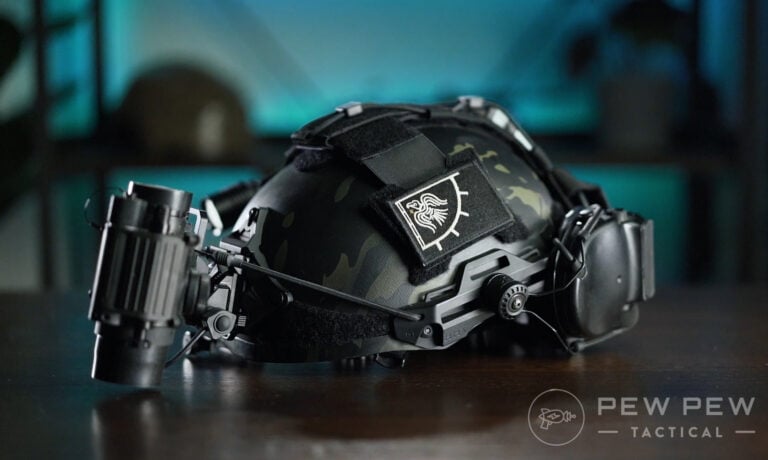










7 Leave a Reply
Hi John, thanks for the awesome article/info!
I have a HHV ATE Gen 2 with a front up armor plate and Wilcox G24. I’m at the NV stage right now. What are your thoughts on the new ATN TICO LT clip on series of monoculars? And what is needed to mount the monocular to the G24 if anything.
Thank You
Good article John, thanks for putting in the time. Expensive, but fun hobby
Just because you can doesn't mean you SHOULD. Maybe you should have just donated thousands of dollars to charity.
And that’s exactly how I feel about your comment. Just because you could, doesn’t mean you should. If You don’t have anything nice to say just move along.. instead of showing what a giant Richard you are
"Something nice"? OK, snowflake. I'm a Richard because kids are starving and I point that out.
More people thinking like you, Prepper, means more children starving. The first word to mind is simpleton. Also kind-hearted but with lacking any sense of the appropriate. Where children are starving it is because of NV, it is because of corruption, a poor economy, usually a combination of the two. No amount of giveaways will cure that. Even in this relatively well functioning country (economically) our "war on poverty" has absorbed enough trillions to make everyone poor, rich. To zero effect. John/Eric has stimulated the economy here. He's produced jobs. A strong economy, like a rising tide, lifts all boats. It's simply not possible to effectively lift just the sinking boats - take water from here , put it under that sinking boat, which probably has holes in it anyway . . ..
Maybe you should put your money where your mouth is. How much have you personally donated to feeding poor children?I will take your name to indicate you are a prepper. Takes a lot of money to become a prepper. Food, resources, storage, and firearms to protect at all, unless you plan to use your abrasive personality to keep people away. What a waste of money, preparing for “what if’s “ in your paranoid simple thinking..You should’ve donated all that prepping money to feeding poor children. You’re dismissed